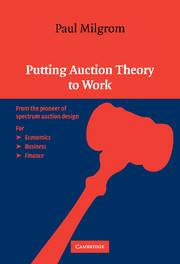1 - Getting to Work
Published online by Cambridge University Press: 05 June 2012
Summary
The era of putting auction theory to work began in 1993–1994, with the design and operation of the radio spectrum auctions in the United States. Although the economic theory of auctions had its beginnings in the 1960s, early research had little influence on practice. Since 1994, auction theorists have designed spectrum sales for countries on six continents, electric power auctions in the United States and Europe, CO2 abatement auctions, timber auctions, and various asset auctions. By 1996, auction theory had become so influential that its founder, William Vickrey, was awarded a Nobel Prize in economic science. In 2000, the US National Science Foundation's fiftieth anniversary celebration featured the success of the US spectrum auctions to justify its support for fundamental research in subjects like game theory. By the end of 2001, just seven years after the first of the large modern auctions, the theorists' designs had powered worldwide sales totaling more than $100 billion. The early US spectrum auctions had evolved into a world standard, with their major features expressed in all the new designs.
It would be hard to exaggerate how unlikely these developments seemed in 1993. Then, as now, the status of game theory within economics was a hotly debated topic. Auction theory, which generated its main predictions by treating auctions as games, had inherited the controversy.
- Type
- Chapter
- Information
- Putting Auction Theory to Work , pp. 1 - 34Publisher: Cambridge University PressPrint publication year: 2004
References
- 1
- Cited by



